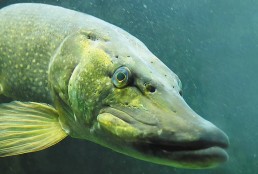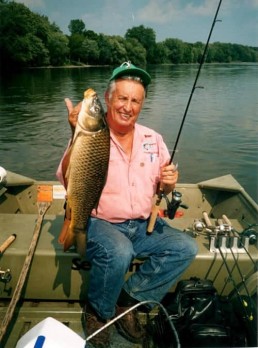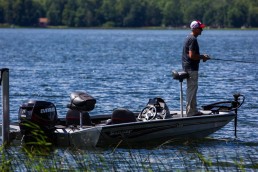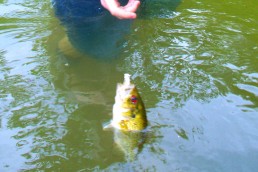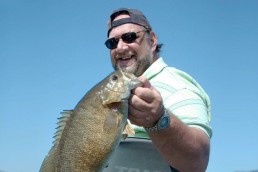Eye of the Gamefish
SHARE THIS POST
New underwater observations suggest that gamefish of many species take a good long look, from multiple angles, before deciding whether to bite. In addition to a visual inspection, it’s likely they’re following their noses, too. What it means to you, when you’re out there fishing.
Once again, “Bobber” Anne’s ability to hone in on fish reactions on her underwater video camera has opened our eyes to a new facet in how fish identify food they’re about to attack.
While we were filming underwater footage of walleyes striking our new Spin Bee lure in a Benthic Zone on the Ogoki River in northern Ontario, we were confronted with an odd happening: Anne had captured several strikes on video when suddenly an 8-pound northern pike entered the picture. We thought he was after one of the smaller walleyes, which were aggressively charging our Spin Bee.
Not so!
This pike was after my Spin Bee, not the hooked walleye. With the walleye boated and released, I lowered my Bee back into the Zone where we’d last seen Mr. Pike. Instantly, he slid in behind the lure, his nose but 6 inches behind it.
What happened next surprised us.
The video monitor showed the pike’s eyes focused forward on the Spin Bee. Later, all of this was confirmed when reviewing the underwater tape. Once positioned behind the lure, the pike, after about 10 seconds, slid off to the left side and advanced forward, his right eye pivoting to focus directly on the bait. Mr. Pike was now only inches from the lure, his eye riveted on the Spin Bee. (Note: As video was being shot, Anne made mention that the pike’s eye actually pivoted in its socket. This was a fact that either of us knew was possible.)
When she mentioned this had happened, I was at a loss for words. Next, the fish slid back, its nose a mere 2 inches from my lure. He held for three seconds or more with his mouth opening and closing a couple times, as his eyes focused forward, and locked on the target. It was a reaction in which it seemed he was analyzing whether to eat or not to eat.
Then, the pike slid slightly to his right, turned toward the Spin Bee, opened his mouth and consumed it. Three minutes later, it lay flopping in our landing net on boat bottom.
This wasn’t the first incident where Anne and I had viewed fish eyeballing our baits. Trolling Spin Bees and Fish Fry on Devils Lake in North Dakota produced several occasions where walleyes performed similar actions we’d observed on the Ogoki River. Walleyes would follow the bait closely—18 inches behind—for a matter of 30 seconds, then slide up beside it on one side or the other. As they came alongside their eyeball would rotate accordingly. After a couple seconds, unlike that pike strike, they’d turn and consume the bait.
I believe two instincts were at play: One, they followed the bait closely to intake small extruding scent from the worm or minnow tip. And two, the eyeballing from the side was to assure themselves that the bait was a style they could consume.
Are you enjoying this post?
You can be among the first to get the latest info on where to go, what to use and how to use it!
In answer to your possible question, no, not all the walleyes we encountered on Devils Lake performed in this manner. But enough did to establish that the facts we’d uncovered on the Ogoki River were true.
Since those two situations, Anne has filmed more than just pike and walleyes performing in such a manner. Bass, sturgeon, carp, and panfish have been filmed doing similar eye movements approaching lures.
This past summer, while trolling Spin Bees on the Upper Mississippi, we filmed smallmouth bass using their eye movement to analyze the bait before striking; the same was true of rock bass. Suckers—red horse and hognose species—performed similar acts. Suckers did the eyeballing in a much slower manner. Suckers would approach a bait from behind and watch it for a matter of 20 to 30 seconds and from about 2 feet. Once satisfied that it smelled okay, it would move up to within 1 inch or 2, hold for another five seconds, and then slowly suck the bait in as their snout “accordioned” in and out. At times, as this fish moved in close, it too would move to one side or the other to eyeball the bait before backing off to suck it in.
What does this knowledge do for the angler? How can he take advantage of it? I can only guess and lay out my opinion.
Tipping any lure with scent may be more important than we once thought. The angler who fails to use a scenting device may be missing many opportunities to catch fish that may back off after inspecting their lure offering.
(Note: Dan and “Bobber” Anne often revert to an anise-scented egg they call a “Red Ball” to tip their lure with. These Red Ball eggs can be used on any type of fishing bait for scenting. And maybe to the angler’s surprise, these Red Ball eggs can be used over and over again. Once used, take them off and put them back in the zippered bag they came in. Red Ball eggs are an excellent substitute when the angler runs out of minnows, worms or grubs for tipping.)
Allowing time in your presentation may be more important than one thinks, especially when fish of all species are slow to strike. Therefore, a trolling presentation may at times be better than casting and retrieving. We’ve noticed that extra time is especially helpful when vertically jigging while drifting for walleyes. We’ve observed walleyes will follow a jigging lure as much as 40 to 60 feet before deciding to strike or reject the idea.
There’s much more to learn about the fact that fish host the ability to eye your offer. Anne and I will continue to research this and bring you our findings in future issues of MidWest Outdoors.
Considered one of the world’s leading river anglers, Dan Gapen, Sr. will continue to recount his past and recent adventures and offer up his knowledge to MidWest Outdoors readers.
MWO
SHARE THIS POST
Did you enjoy this post?
You can be among the first to get the latest info on where to go, what to use and how to use it!
Dan Gapen
Considered one of the world’s leading river anglers, Dan Gapen, Sr. has shared his knowledge with MidWest Outdoors readers and viewers for more than 40 years. He is a member of all three Fishing Halls of Fame—International, National Freshwater, and Minnesota. He has an immense grasp of the world’s fisheries. He may be contacted at 877-623-2099.
@TheGapenCompany.
